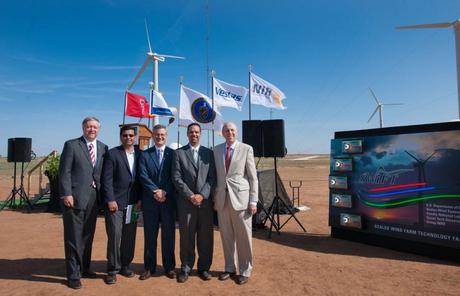 SWiFT — Scaled Wind Farm Technology Facility. (Credit: Texas Tech University)
SWiFT — Scaled Wind Farm Technology Facility. (Credit: Texas Tech University)A new wind research facility at Texas Tech University was commissioned on July 9. Officials from Texas Tech, Department of Energy, Sandia National Laboratories, Vestas and Group NIRE were present at the new Scaled Wind Farm Technology (SWiFT) facility to mark the occasion. The SWiFT is the first public facility of its kind to use multiple wind turbines to measure how wind turbines interact with one another. The facility will help to address wind farm underperformance, much of which can be attributed to turbine-to-turbine interaction.
“Some estimates show that 10 to 40 percent of wind energy production and revenue is lost due to complex wind plant interaction,” said Jon White, Sandia’s technical lead for the project.
White said the SWiFT facility allows for rapid, cost-efficient testing and development of transformative wind energy technology, with specific emphasis on improving wind plant performance. The facility’s advanced testing and monitoring will help researchers evaluate how larger wind farms can become more productive.
The site includes two V27 research turbines deployed by the Department of Energy and Sandia, and a third V27 turbine belonging to Vestas, a leading wind turbine manufacturer.
“The completion of the SWiFT facility marks a new and exciting chapter of wind research at Texas Tech University,” said Kent Hance, chancellor of the Texas Tech University System. “Research generated from this venture will enhance the capability of wind turbines, help develop wind power systems of the future and further Texas Tech’s position as a leader in the wind energy industry. We are grateful to our multiple partners who helped make this important project a reality.”

Texas Tech chancellor Kent Hance, far right, and presdient M. Duane Nellis, far left, post with officials from the Department of Energy, Sandia National Laboratories and Vestas. (Credit: Texas Tech University)
The SWiFT facility could eventually expand to include nine or more wind turbines, which would allow researchers to further examine how individual turbines and entire wind farms can become better “citizens of the grid” and how to be more productive and collaborative.
“Our researchers at Texas Tech University are working to better understand and enhance methods to harness wind energy, and it is vital we forge ahead and discover the full impact this energy source can have on our society,” said Texas Tech President M. Duane Nellis. “Today’s commissioning ceremony of the Scaled Wind Farm Technology facility is a testament to the commitment of the university and its partners to standing at the forefront of wind research, nationally and globally.”
Sandia announced in July 2011 that it would move its wind energy test facility to Lubbock, funded by the Department of Energy’s Wind and Water Power Program.
“For Vestas, the commissioning of SWiFT marks the realization of a technology-acceleration vehicle,” said Anurag Gupta, who works for Vestas Wind Systems’ product integration team. “With its intersection of scale and design, this vehicle provides both cost-effective accuracy as well as the ability to bridge fundamental and applied research at the power plant level. This will help Vestas to quickly drive organic and partner innovations to market.”In April 2012, Vestas and Group NIRE, a renewable energy development company, signed a Memorandum of Understanding that allows use of the facility for collaborative and proprietary research, depending on the research need.
Revenue generated from the energy produced by the Vestas turbine will be directed toward a Vestas Wind Research Program through Texas Tech’s National Wind Institute (NWI). Revenue generated from the energy produced by the Sandia turbines will be directed towards supporting NWI graduate students conducting Sandia wind research projects.

